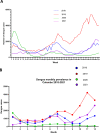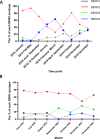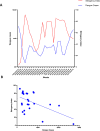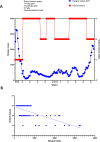Epidemiological and virological factors determining dengue transmission in Sri Lanka during the COVID-19 pandemic
- PMID: 36962516
- PMCID: PMC10021909
- DOI: 10.1371/journal.pgph.0000399
Epidemiological and virological factors determining dengue transmission in Sri Lanka during the COVID-19 pandemic
Abstract
With the onset of the COVID-19 pandemic in early 2020 there was a drastic reduction in the number of dengue cases in Sri Lanka, with an increase towards the end of 2021. We sought to study the contribution of virological factors, human mobility, school closure and mosquito factors in affecting these changes in dengue transmission in Sri Lanka during this time. To understand the reasons for the differences in the dengue case numbers in 2020 to 2021 compared to previous years, we determined the association between the case numbers in Colombo (which has continuously reported the highest number of cases) with school closures, stringency index, changes in dengue virus (DENV) serotypes and vector densities. There was a 79.4% drop in dengue cases from 2019 to 2020 in Colombo. A significant negative correlation was seen with the number of cases and school closures (Spearman's r = -0.4732, p <0.0001) and a negative correlation, which was not significant, between the stringency index and case numbers (Spearman's r = -0.3755 p = 0.0587). There was no change in the circulating DENV serotypes with DENV2 remaining the most prevalent serotype by early 2022 (65%), similar to the frequencies observed by end of 2019. The Aedes aegypti premise and container indices showed positive but insignificant correlations with dengue case numbers (Spearman r = 0.8827, p = 0.93). Lockdown measures, especially school closures seemed to have had a significant impact on the number of dengue cases, while the vector indices had a limited effect.
Copyright: © 2022 Ariyaratne et al. This is an open access article distributed under the terms of the Creative Commons Attribution License, which permits unrestricted use, distribution, and reproduction in any medium, provided the original author and source are credited.
Conflict of interest statement
The authors have declared that no competing interests exist.
Figures





References
-
- Zeng Z, Zhan J, Chen L, Chen H, Cheng S. Global, regional, and national dengue burden from 1990 to 2017: A systematic analysis based on the global burden of disease study 2017. EClinicalMedicine. 2021;32:100712. Epub 20210106. doi: 10.1016/j.eclinm.2020.100712 ; PubMed Central PMCID: PMC7910667. - DOI - PMC - PubMed
-
- Chen Y, Li N, Lourenco J, Wang L, Cazelles B, Dong L, et al.. Measuring the effects of COVID-19-related disruption on dengue transmission in southeast Asia and Latin America: a statistical modelling study. The Lancet infectious diseases. 2022. Epub 20220302. doi: 10.1016/S1473-3099(22)00025-1 ; PubMed Central PMCID: PMC8890758. - DOI - PMC - PubMed
-
- Surendran SN, Nagulan R, Sivabalakrishnan K, Arthiyan S, Tharsan A, Jayadas TTP, et al.. Reduced dengue incidence during the COVID-19 movement restrictions in Sri Lanka from March 2020 to April 2021. BMC public health. 2022;22(1):388. Epub 20220224. doi: 10.1186/s12889-022-12726-8 ; PubMed Central PMCID: PMC8866919. - DOI - PMC - PubMed
Grants and funding
LinkOut - more resources
Full Text Sources
